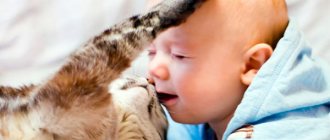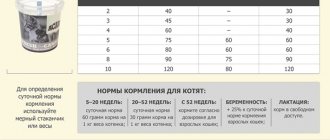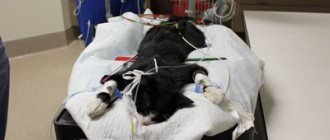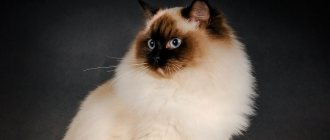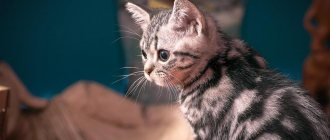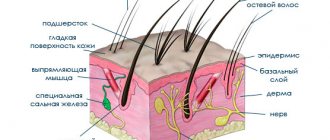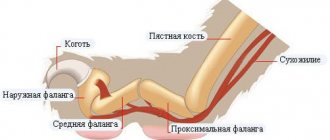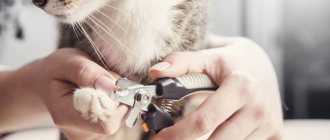Often cat owners pay a lot of attention to the choice of food and do not think at all about the dishes from which their furry pets will eat. But this is also an important factor in the cat’s health and comfort. If you have ever noticed that your pet takes food out of its bowl and eats it from the floor, or often refuses food altogether, then you may want to think about changing the bowl.
Material
Typically, cat bowls are represented by the following materials:
Plastic
Plastic bowls The most common and inexpensive material for cat bowls. The quality of plastic varies from product to product:
- Cheap material can have an unpleasant odor, and also absorb the smell of food, bend, crack, and even release dangerous toxic substances - phthalates.
- More expensive and high-quality plastic does not have these flaws, and its service life is much longer.
However, be that as it may, in most cases this material has a porous structure in which pathogenic bacteria can multiply, even if you wash the bowl regularly. In particular, the occurrence of acne in cats is associated with plastic bowls. Plastic, especially cheap plastic, is not our option.
Metal bowls
Metal bowls are much more durable than all others.
They usually have a rubberized base that prevents the bowl from sliding on the floor. Stainless steel utensils are absolutely safe for health and easy to clean, but they are also much more expensive than plastic ones. There is, however, one aspect - dry food can rustle and ring in a metal bowl, which the animal may not like.
Glass, porcelain, ceramics
Ceramic and porcelain bowls do not have a porous texture, are safe for health, and are easy to clean both by hand and in the dishwasher. In addition, such dishes are available to everyone - probably every house has a couple of saucers or small plates lying around. However:
- such bowls can be accidentally broken (unlike plastic and metal ones);
- they can slide on the floor (as they are usually not equipped with rubberized legs or a base);
- If you preheat food in such a container, you or your pet may accidentally get burned.
Glass bowl We conclude - plastic is bad, glass, ceramics and porcelain are acceptable, metal is good, but expensive. But material is not everything! The shape of the bowl is of great importance.
The best premium bowls
Darell 1082 ECO 2 x 700 ml
The feeder has an adjustable stand, painted black. The stand and bowls are made of stainless steel. This material promotes long-term operation regardless of conditions. The volume of installed containers is 700 ml. It is enough for a medium-sized pet weighing from 6 to 15 kg. It is suitable for breeds with a long nose. Height - 40 cm.
bowl Darell 1082 ECO 2 x 700 ml
Advantages:
- height adjustment;
- quality material;
- does not turn over;
- sustainable.
Flaws:
- no assembly instructions;
- The cup clamp does not cope with the task (it rattles a lot).
TRIXIE 24640 2 * 250 ml
The new product will help provide your pet with free access to food and water. It will help you properly organize your dog’s feeding area. The curved metal stand is painted with anti-corrosion powder paint. The coating can withstand minor physical impact. Rubberized legs will ensure that the structure is stable and does not move. There is a slot at the top to accommodate 2 ceramic containers. Their volume is 700 ml. For convenience, we received prints and inscriptions on the outside and inside.
bowl TRIXIE 24640 2 * 250 ml
Advantages:
- ceramic product;
- wall thickness 3.5 mm;
- Even dried food remains are easily washed off;
- durable environmentally friendly material;
- 4 sizes available to choose from;
- stable stand;
- Made in Germany.
Flaws:
- it is impossible to choose a different color;
- too expensive.
Wet food for cats: rating of the best according to veterinarians
Wet cat food is an alternative to natural food. The high percentage of protein in this food provides all the necessary nutrients and a long-lasting feeling of satiety.
Pros and cons of wet food
There are three types of cat food. One is based on the consumption of natural food, which the person himself eats. The other two are commercial dry and wet food that are sold in pet stores.
Cat health is the result of proper nutrition
Pros of wet food
- Diet variety. High-quality food can be made from meat, poultry or fish, and also contain additives in the form of crab meat, shrimp, vegetables and fruits. You should only experiment with exotic treats if your cat is not allergic.
- Source of protein and fat. A cat's diet should include plenty of protein and fat to meet the animal's needs.
- Large amount of moisture. Dry food is only 10% moisture, so it is important to make sure your cat drinks enough water. When feeding moist (wet) food, which is 75% water, this is not necessary.
- Nutrients and taste appeal. Liquid cat food is less heat-processed. This retains more nutrients and has less impact on taste.
- Portioning. One sachet of wet product is designed for a single meal for an adult cat weighing 5-7 kg.
- Preventing overeating. Cats eat less when fed high-protein wet food, as it helps keep your pet well-fed.
Cat obesity as a result of overeating
Note! For sterilized cats, the number of kilocalories in the diet changes.
Flaws
There are fewer disadvantages to wet food than disadvantages:
- Price. Costs more than dry.
- Deterioration of the oral cavity. Long-term use leads to bad breath. Because the texture of the food is soft, it does not work as a toothbrush and does not prevent plaque and tartar buildup. In this case, the owner must monitor the cat’s oral hygiene himself using a special toothbrush and toothpaste.
- Perishable product. Wet food in a bag or bowl can stand at room temperature for no more than two hours, after which the contents are no longer suitable for feeding.
Veterinarians do not recommend basing your cat's diet solely on wet food. Only a combination of dry and wet gives a diet as close as possible to natural in nature.
Feeds are ranked by class: from economy to super premium. The difference comes down to the composition of the canned food for cats - the quality rating is presented below.
Important! You should not mix food from different manufacturers.
The best wet food for cats and economy class cats
The main advantage of such nutrition is its reasonable price. In addition, each brand has its own advantages.
Economy class food
Whiskas
The line includes meat and fish flavors, vegetable stew, and wet food for kittens.
- price 15-25 rubles per package*;
- vitamins and minerals included.
- high content of wheat, an allergen for cats;
- low percentage of protein content.
Perfect Fit Sterile
Created specifically for spayed and neutered cats. The recipe is based on controlling the weight and urine pH of a four-legged pet.
- price 25-30 rubles per package*;
- zinc and sunflower oil to improve wool quality;
- a complex of special minerals against the formation of kidney stones.
- Strong smell;
- cereals;
- proteins from animal flour and soy concentrate.
"Our Brand"
The best canned food in the low price segment due to the high level of natural animal protein in the composition of food in this category - at least 15%.
- price 25-30 rubles per 100 g*;
- prebiotic included.
- The basis of the food is corn, an allergen for cats.
Felix “Appetizing Pieces”
A wide selection of flavors will help diversify your cat's diet.
- price 25-30 rubles per package*.
- there is no information on the ratio of animal and plant proteins;
- flavorings, dyes.
Sheba
This wet food is also inexpensive.
- soy free;
- price 30-35 rubles per package*.
- offal and processed meat products.
Important! The advantage over analogues is the absence of cereals, a dangerous allergen for cats.
Friskies
Not the most recommended option for wet cat food, since the first ingredient in the composition is grains.
- Price 15-20 rubles per package*.
- offal, both meat and vegetables;
- unknown dyes and preservatives.
Rating of premium wet cat food
If your budget allows, you can switch your pet to a premium diet. However, the opinion of veterinarians is that it is better to use these foods in cases where the cat has certain health problems.
Premium food
Dr. Clauder's Anti Struvit diet
Canned food is intended for the prevention of urolithiasis.
- high percentage of protein and low percentage of grains (rice only);
- two volume options: 200 g and 400 g.
- price 150 rubles per 200 g*;
Animonda
German manufacturer of wet food in canned and pouch formats.
- free of grains, soy, sugar, artificial colors and preservatives;
- for cats of different ages;
- natural proteins and fats.
- price 150-200 rubles per 200 g*;
- by-products among the ingredients.
Hill's
The American company Hill's has created three lines for cats: Prescription Diet for disease prevention, Science Plan and Ideal Balance for a daily diet.
- Available in the form of canned food and pouches;
- reasonable price 65-70 rubles per 85 g*.
ProPlan
Proplan premium food produced by Purina. Some factories are located in Russia, so the batches are tested by an independent commission of quality. Suitable for disease prevention and daily diet.
- The medicinal food contains natural meat;
- price 65-75 rubles per 85 g*.
- high percentage of soy and corn content;
- small amount of vegetables in the composition;
- animal fat, liver, offal flour.
Anti-rating of premium wet food
Food from some manufacturers causes deterioration in the health of cats. It’s worth knowing about this so as not to make mistakes in planning your diet.
Anti-rating of premium food
Royal Canin
The composition of the Kanin diet is, unfortunately, of low quality.
- components that cause allergies in cats;
- indigestion.
Brit Premium
Economy class ingredients.
- proteins are a mixture of chicken meat flour and dried chicken;
- rice and wheat included;
- the number of special ingredients (sources of vitamin B and MOS, herbal and fruit extracts) that increase the cost of feed is extremely small. It will not affect the cat's health in any way.
ProBalance
Composition of economy class products at a premium price.
- no palatability for cats;
- cereals;
- unpleasant odor;
- The guaranteed volume of vitamins is low and does not contribute to improving the health and appearance of the pet.
Eukanuba
Low quality composition.
- high price for such a composition;
- no meat, only animal proteins;
- unknown preservatives and antioxidants.
Note! Some veterinarians attribute the growth of cancerous tumors in animals to the consumption of this food.
To keep your pet healthy, you need to choose the best canned food for cats.
Super premium wet food rating
As a rule, this is food with natural ingredients, however, finding it in stores can be difficult.
Super premium food
Leonardo
The composition of German canned food and pouches from Leonardo is completely natural. The food is one of the top 5 foods recommended by experts.
- 70-90% of the composition is chicken meat; the remaining 10% - seafood, fish, fish oil and offal;
- natural preservatives (tocopherols).
- Not sold in all pet store chains.
Applaws
Applaws fully meets customers' expectations of European quality standards. None of the diets presented by the UK manufacturer contain grains or gluten.
- high percentage of ingredients made from natural meat;
- All grains have been replaced with potatoes, which are easily digestible by the cat’s gastrointestinal tract;
- low price for food of this level.
- Not sold in all pet stores.
GimCat
Food for picky gourmets. Whole pieces of fish and meat, complemented by exotic fruits such as papaya and mango, set GimCat apart from others.
- up to 90% of the composition is natural fish and meat;
- low price with this composition 90-110 rubles per 1 jar*;
- only rice (3%).
- Once opened, it should not be stored for more than 24 hours.
Bozita
Swiss cat food undergoes strict state quality control. The diet contains an immune system stimulant.
- fish and meat ingredients;
- no dyes.
Opti meal
The composition consists of 80% meat and offal.
Note! To improve digestion, beans and carrots are added as fiber, and cranberries act as an antioxidant and help normalize the functioning of the urinary tract.
- high protein content;
- food is enriched with vitamins and minerals;
- prebiotics for digestion.
Rating of wet holisticists
These foods are made from products intended for human consumption.
Grandorf
It has an extensive meat menu. Belgian wet food manufacturer Grandorf offers 12 meat and fish menu options. The composition is transparent, like no other food: 75% meat and 25% own juice.
Additional Information! High-quality fillets are processed at low temperatures to preserve all beneficial properties.
- high quality composition;
- An acceptable price for such high-quality food is 90-100 rubles per can.
- Not sold in all pet stores.
Hill's Science Plan Feline Adult 7+ Youthful Vitality
Designed for aging cats over 7 years old. A balanced diet enriched with vitamins C and E is designed to maintain the health of an elderly animal by increasing immunity and slowing down the aging process.
- natural composition;
- 2 flavors to choose from: meat and fish;
- affordable price when purchasing food with a special formula - 70-80 rubles per package*.
- large pieces that are difficult for a cat to chew if they have dental problems that arise during aging.
Advice! It is worth following the manufacturer's recommendations when choosing food for your cat.
Solid Natura Selection
Canned wet food for kittens and adult cats, consisting of 97% meat, is produced by the Yelets meat processing plant. The diets are monoprotein and are based on veal, rabbit, quail, chicken and turkey.
- natural composition;
- no soy, GMOs, dyes.
- Due to the lack of taste and smell enhancers, some cats are reluctant to eat.
High-quality wet food is a good addition to your cat's diet. The healthiest food will be food made from natural animal protein, without grains and with natural preservatives. An option close to this composition can be found from manufacturers of each class. The list above will help with this.
With proper functioning of the gastrointestinal tract, all useful substances are absorbed, which affect the thickness of the coat, bone strength and the condition of the body as a whole. A healthy, well-cared-for cat can live 15-20 years and be a joy to its owner.
*Prices are current as of October 2021
general information
Where to put it?
One of the primary tasks facing the owner is organizing a place for eating. It must be in the right place and fully comply with natural habitat conditions.
This is an untouchable permanent territory used to satisfy hunger and thirst. They are accustomed to it from childhood.
The location has a number of specific requirements:
- Spacious area, it must be taken into account that the dog will grow over time;
- drafts, air conditioners, heating devices and high humidity levels are unacceptable;
- the best option is the corner of the kitchen or hallway; it is strictly forbidden to place it next to the entrance to the apartment;
- For a pet living on the street, it is necessary to fence off this area in the enclosure and put up a canopy.
It is important to maintain cleanliness. Bowls should be washed after each meal, water should be changed regularly, and tripods and stands should be washed periodically.
Optimal amount of dishes
A dog does not need a lot of things; the minimum is enough for a normal life. Everyone should have their own bowl. Expensive ceramic dishes or an inexpressive iron plate left over from past generations, this, as a rule, does not matter to the pet.
Pet stores offer a wide range of food containers. The most popular questions that beginners have: how many dishes do you need? And where to choose.
For your pet, 3-4 bowls are enough (for water, dry food, liquid food and a spare). For dogs that eat mainly dry food, you should purchase a large water container, preferably a drinking bowl. Because it increases thirst. The automatic drinking bowl is especially relevant for those who are often away for the whole day. Ignoring the rule can lead to digestive problems and deterioration in general condition.
It is possible to purchase double options united by a common tray. They are easy to use and durable. But there are several nuances to consider.
- Manufacturers produce only models of small sizes. This design is not convenient for large breeds.
- Basically the second half is filled with water. While eating, particles can fly in different directions, including into the water. The fluid needs to be replaced.
Eating will bring joy and will not cause problems if the bowl meets a number of requirements.
- Should not slide or tip over. They resort to using suction cups on the bottom, as well as stands and tripods. It is worth noting that even tall dogs can eat from a floor bowl. There is a common misconception that this will cause problems with posture and back. Before purchasing a tripod, study it carefully. It should be rigid, the bowl should not move or rattle.
- Side height. It is strictly forbidden to use flat models with low sides. The characteristics are affected by the breed of the pet. For long-haired dogs, tall and narrow bowls are preferred, preferably cone-shaped. They minimize the chances of hair getting into the food and water. For lop-eared dogs, narrow solutions with a cut cone shape are suitable. Dogs greedily consume food. To slow down, models with limiters are used. They are implemented with one large or several small protrusions. Their task is to slow down the process.
- Pallets. Relevant for sloppy pets. They can take food out of the container and finish it on the floor, or splash water. The trays are easy to wash or wipe with a damp sponge. Plates mounted on pallets do not lie on the floor and are highly stable. If desired, the dishes are removed from the tray. Alternatively, rugs can be used.
Material of manufacture
Manufacturers compete for customer attention. Such models will not leave anyone indifferent. They successfully compete with ordinary plates, which remain on the shelves almost unnoticed by anyone. Regardless of the appearance and design, pay attention to the material of manufacture. It affects service life and safety. Budget containers need to be changed more often, as scratches and chips appear on their walls over time. Neoplasms are dangerous, can injure your pet, and also become a good environment for the development of bacteria and microorganisms that cause intestinal diseases.
- Plastic. Budget group. It has a bright and catchy color that will not leave anyone indifferent. The abundance of forms presented is impressive. Those who decide to give preference to this material need to carefully study the composition. It should not contain admixtures of toxic substances. Only environmentally friendly materials! It is not advisable to purchase products that are brightly colored or have a strong plastic smell. If you put heated food in such a container, it will act as a catalyst for the release of toxins. Subsequently, the animal will be poisoned. Plastic plates are not stable. Rubberized feet do not improve the situation. Contraindicated for animals with strong jaws. Snacking on the container will not be difficult; the fragments may damage the oral cavity. Small sharp parts, once inside, will cause internal bleeding. Cracks and micro scratches that occur during operation will become a source of development of bacteria and microorganisms. Such problems can be avoided by thoroughly washing and wiping dry. The material quickly absorbs odors, as a result the pet may refuse to eat from it.
- Metal. An attractive solution at a reasonable price. It is resistant to minor impacts and damage, lasts a long time and does not rust. The surface cannot be damaged or scratched. The only thing you need to monitor is the condition of the enamel. If a chip occurs, the dishes must be replaced immediately. The non-porous texture prevents the growth of bacteria. Steel bowls are equipped with rubberized feet, which increase stability and prevent slipping; the widened base makes it difficult to turn over. The cookware is compatible with all types of food (dry food, raw meat, dairy products and vegetables). The container fits onto the stand without any problems. It is strictly forbidden to wash the product with steel wool and aggressive chemical compounds. High noise levels during eating can cause some inconvenience for owners.
- Ceramics. The optimal solution for small, calm dogs. Not recommended for puppies. Contraindications are due to the fact that the bowl is easy to break. For greater safety, it is recommended to use a stand. The ceramic surface is easy to clean from food debris and other dirt. Special rubberized inserts prevent slipping. It is allowed to heat food in the microwave. In addition, ceramics do not absorb odors. Disadvantages include high cost and fragility. Even if the product survives physical impact, it will develop chips and scratches. The animal can get hurt, and harmful bacteria actively multiply in the cracks.
Selection of the optimal size
This characteristic causes problems for almost every owner. As a result, the dog eats from dishes that are not the right size. The following signs will help you identify an error in selection:
- during feeding, food constantly crumbles;
- the portion occupies the full volume;
- drinking is accompanied by spilling of water;
- in 1 dose, the pet absorbs more than a third of the water in the container.
Buying a bowl that is oversized will create additional difficulties for your pet. Experienced dog handlers have deduced the dependence of volume on breed and weight.
- 150 - 250 ml. For miniature breeds (Chihuahua, Toy Terrier, Yorkshire Terrier).
- 300 - 500 ml. For dogs weighing 3 - 6 kg (Spitz, Shih Tzu, miniature poodle).
- 600 - 800 ml. Permissible body weight 6 - 15 kg (dachshund, cocker spaniel, pug).
- 1000 - 1500 ml. Weight ranges from 15 to 40 kg (Labrador, Husky, English Bulldog).
- 2 - 3 liters. For large breeds (Newfoundland, Rottweiler, Bernese Mountain Dog).
What are they?
- Single. A simple and convenient option. Easy to clean. It won't be difficult to choose the right size option. Due to its variable dimensions, it is often used as a water container.
- Simple with a wide bottom. Trapezoidal bowl. Available in plastic or metal versions. It is almost impossible to turn it over. Not recommended for use with water. The dishes create a visual illusion that significantly increases its dimensions. This often leads to the mistaken purchase of an item that is not the correct size.
- Sippy cup. It’s not uncommon for pets to spill water on the floor or spill food. The device is designed to make it easier to maintain cleanliness in the house. Suitable for large and untidy pets. A special compartment supplies water to the upper part in small portions. This minimizes the chances of water spillage. For greater convenience, the container is tilted.
- Double. The group is equipped with rubber feet for stable placement on the floor. Allows you to place water and food in one structure. They have small dimensions. They are produced mainly from plastic. The design will require owners to constantly monitor the contents. Placing the bowls too close leads to mixing of the filler.
- On a stand. The set consists of 2 vessels. Height adjustment is provided. They are characterized by long-term use and, with proper care, will last a lifetime. There are models where there is no possibility of adjusting the height. They received small plates, the stand plays the role of fastening so that the dishes are stable and stand in place.
- With holder. Special travel bowl used in cages. Suitable for long journeys on the train, plane, at exhibitions and more. It is relevant in situations where the dog is in a cage for a long time. The design is mounted on the wall and does not take up space. It does not restrict movement in confined spaces.
- With timer. Divided into a certain number of sectors covered with a lid. On the control panel you can set the opening time of each compartment. A real find for those who spend most of their time at work. Designed for feeding at least 4 times a day. Not every pet, if left with a lot of food, will periodically eat from there. The dog may eat too much, causing digestive problems, or scatter the leftover food.
How to choose?
Beginners who have just adopted a small puppy try to provide him with everything he needs. Having visited the nearest pet store, they are wondering which feeding containers to choose. It should appeal to your four-legged friend and be safe.
Experienced dog handlers recommend:
- Pay attention to the length of the ears. For pets with floppy ears (spaniel, etc.), deep dishes that gradually become narrower are suitable. They minimize contact with food of foreign body parts and will help you always remain neat.
- The structure of the muzzle. Yorkie, pug, Pekingese and similar breeds will require wide, not deep dishes, otherwise it will be inconvenient for them to get food from the bottom. Dogs with a long nose (shepherd, etc.) prefer narrow, deep bowls. In addition to the length and shape of the nose, the size of the pet is taken into account.
Criteria for the bowl itself:
- Size. Determining factor. They are guided by a simple rule: a single serving cannot occupy more than half the area. The sides are deep enough. This will help avoid food spillage when the pet, eating the leftovers, pushes forward. Large volumes of containers are purchased for water. It is important to keep the fluid clean and change it regularly.
- Material. Dishes are made from plastic, metal and ceramics. Each has its own strengths and weaknesses. They choose based on the personal preferences and capabilities of the owner.
- Form. Choose based on breed. Convenient dishes are equipped with a round bottom. Compared to rectangular and square options, food does not get stuck in the corners.
- Do you need a stand? The solution prevents the dog from bending low to the floor, and also provides additional stability. It will act as an additional barrier so that the puppy does not climb into the container with all 4 paws.
- Heating. Normal functioning is only possible if the dog eats food at room temperature. A thermal bowl will heat water and food in the fall and cold seasons. Reliable protection of wires from damage is provided.
Form
An example of a proper bowl is a flat saucer that does not touch the whiskers. The most common form of a cat bowl is a more or less deep plate of small diameter with high sides.
Sometimes it is wider at the base and seems to taper at the top. Often two bowls - for food and water - are combined into one. And so the owner, satisfied and proud of himself, having acquired such a bowl, puts delicious food into it with a generous owner’s hand and... watches in disappointment as the cat pulls a piece out of the bowl and eats it on the floor. Why is this happening?
- Many cats prefer to eat as if reclining or sitting on half-bent legs (squatting), and high sides make it difficult to take their favorite position.
- Cats don't like it when the edges of the bowl... touch their whiskers! Vibrissae - tactile organs - are very sensitive, and excessive rough touches irritate the animal and can even provoke a stressful state.
- Flat-faced cat breeds, such as Persians and exotics, experience all of the above difficulties at once: the whiskers, you know, get hurt, and you have to put your whole head into the bowl.
A plastic bowl especially for Persian and British cats has low sides and a ribbed bottom. Thus, we conclude: the lower the sides and the wider the “mouth” of the bowl, the better. Ideally, this is the most common flat plate or saucer familiar to all of us. The box just opened! However, such a bowl also has a drawback - food can periodically end up “overboard”, so a bowl that is too flat is also bad. But that's not all!
Where is the best place to put a cat bowl?
Cats, like people, prefer to eat in a quiet environment. So it is better to place the bowl where no one will disturb the cat while eating - away from doors, places where children play and other increased activity.
It is worth taking into account that the cat will not eat near the place where its toilet is located. It is optimal to leave the cat's bowl in the kitchen. Many pet owners put away the food bowl, taking it out only during meals. However, make sure your cat always has access to fresh water. Also make sure your cat's bowls are always clean.
In some cases, cats have favorite places for eating, and she will hint at this through her behavior, for example, by trying to move her bowl there or taking food out of the bowl and dragging it with her paws to the right place, and then eating it. In this case, you just need to monitor your pet’s behavior.
Basic habits are developed in childhood, including habits related to eating.
The author's cat eats in the kitchen. Her bowls are under the radiator. I feed him twice a day and water is always available. The animal never expressed any protest or concern about the location of her bowl, although, frankly, no one asked her opinion. I simply chose this place as the optimal one, where nothing would interfere with the animal’s ability to eat in peace, and the animal would not disturb anyone while eating.
How does the cat breed influence your choice?
Does what breed a pet belongs to affect the choice of dishes? Yes!
And all this is due to the variety of cats' faces.
For example, the favorites of the British or Persian or exotic breeds have a flattened nose and a small “retracted” jaw.
Will such cats be able to reach the bottom of a deep bowl? Of course not!
Consider the long-haired beauty of the Norwegian forest cat .
The fluffy fur of such a cat will often get dirty if the animal is forced to eat from a shallow plate.
Therefore, it is recommended to choose a bowl based on the breed characteristics of your pet.
Important! Canned food and other soft foods are best served in containers with low sides, while dry food and liquids are best served in containers with high sides.
Everything has been decided with depth, but what to do with dimensions?
Surely it will not be news to every pet owner that for large pets (for example, the same caracals ) it is more practical to use large-sized dishes.
And for small cats such as bobtails, a medium-sized bowl is suitable.
Nowadays, stores are full of a variety of bowls; everyone can choose a product to suit their taste.
Bowl shape and size
- The bowl should be wide enough. It is advisable that the cat does not have to fish out food while eating. Narrow sides irritate many cats not only because of the inconvenience, but also because the cat constantly touches the sides of the bowl with its whiskers and whiskers. Whiskers and vibrissae are very sensitive areas.
- The depth of the bowl should be medium. You don't want your cat to dive headfirst into the bowl. But an option that is too flat will be inconvenient - the food may spill out. 3-4 cm is the optimal depth.
Do you need coasters and mats?
Examples of stands - wooden, metal and plastic The range of cat gadgets is full of different stands, ranging from plastic to wooden. Their purpose is to give the bowls stability, to please the owner's eye aesthetically, and to prevent food and crumbs from spilling on the floor. Some of them are attached to the wall, leaving space on the floor free. But as practice shows, many cats don’t like them. Why?
- Metal stands again prevent the cat from adopting a “half-bent” position; even if they are adjustable in height, they will still have to be lowered to the floor as much as possible - why not just do without them?
- Wide stands in the form of a tray or stands with niches into which bowls are inserted are also not liked by everyone, since they either raise the bowls higher or have a fairly large area, but limited by the sides, which makes it difficult for the animal to access the bowl from different sides.
- Rugs can have an unpleasant odor or scare the cat away from the bowl, since for the animal it is an incomprehensible substance that does not want to get its paws dirty. Although the item itself is useful - rugs can also absorb spilled water, some of them even have sensors that will prevent the robot vacuum cleaner from crawling into the bowls.
Silicone bowl mats are suitable for your pet if he prefers to eat while sitting or standing. If you want to keep the floor clean, but the cat does not perceive a beautiful stand or rug, you will have to accept it or use regular paper towels, changing them from time to time. Cheap and cheerful!
How to avoid problems with bowls
- Buy dishes for animals in trusted stores and do not use containers not intended for food.
- Place the cat's bowl in a well-accessible, ventilated place without foreign odors.
- Use a matte, non-slip mat or cat litter to keep the floor clean. It will also help keep the bowl from slipping away from your cat while he eats.
- Make sure your food bowl is filled regularly and change the water promptly.
- Wash your cat's dishes thoroughly before each use, and choose unscented products.
- Do not mix different types of food in one bowl - dry and wet, specialized food and homemade food. If you need to give your cat a varied diet throughout the day, it is better to use double bowls.
Water bowl
The shape of the water bowl is very important, because getting a cat to drink water again is not an easy task. But in reality it's simple:
- The water bowl should have a very wide mouth and low sides.
- The container itself should not be very small - focus on a soup plate or small basin.
- It is better to purchase several of these “basins” and place them in accessible places (but away from electrical appliances).
You can also pay attention to automatic fountains - constantly circulating water attracts cats more than just a bowl of water. A variety of shapes and materials will allow you to purchase a fountain to suit every taste and budget. We examined automatic drinkers in detail in the article of the same name.
The most successful models of cat bowls
- Trixie. A metal bowl with a rubberized bottom is deservedly popular. It is very inexpensive and easy to use.
- "Arc" by Dezzie. A metal bowl with an original plastic stand that slightly raises it above the floor, so that the cat does not have to bend over.
- Rogz Fishcake. The bowl is made of high-quality non-toxic plastic with a silicone bottom and has a good elongated shape so that the cat's whiskers do not touch the edges.
- Hello Kitty Double Ceramic Bowl. Thanks to its design, the sections are located at a distance from each other, and food will not fall into the water.
Gadget bowls
Automatic feeders should be selected according to the following principle:
- not very high sides;
- wide base;
- high-quality plastic (after all, as a rule, such feeders are made of plastic).
There are different types of automatic feeders:
- Some work on the principle of communicating vessels - as soon as the bowl is empty, the container throws out a portion of food.
- More advanced models run on batteries - recently one of our subscribers shared her experience of purchasing such an automatic feeder for six feedings, you can find it here.
There are also interactive feeders, or food puzzles. They are great for animals with eating disorders:
- swallowing food too quickly without biting the croquettes;
- aerophagia;
- vomiting of undigested food and so on.
We looked at the types of such feeders in this article.
How many dishes and what size should I buy?
For a pet, 3-4 bowls will be enough. For water, for dry food, for liquid food, for dairy products and always a spare one. Select a sippy cup for your dog separately. If the puppy eats mainly dry food, it is advisable to purchase a large water bowl, or even better, a drinking bowl. After all, dogs that eat dry food drink a lot of water. The automatic drinking bowl will be a godsend for owners who often leave the dog alone in the house. The pet will always have access to water.
Price
The cost of bowls depends on the material and the presence of additional elements, such as a tripod or tray. So, for example, metal products with a tripod cost from 500 to 3000 rubles, the cost of ceramic ones varies between 200-1000 rubles, plastic containers are the cheapest - about 300 rubles. Automatic feeders are the most expensive; their cost starts from 2000 rubles and depends on the set of functions and the complexity of the design.
Similar articles:
- Paw wash for dogs
- Kiltix collar for dogs
- Tablets for fresh breath from dogs' mouths
- Dog ear cleaners
- Choke collar for dogs
- Outdoor enclosures for dogs
